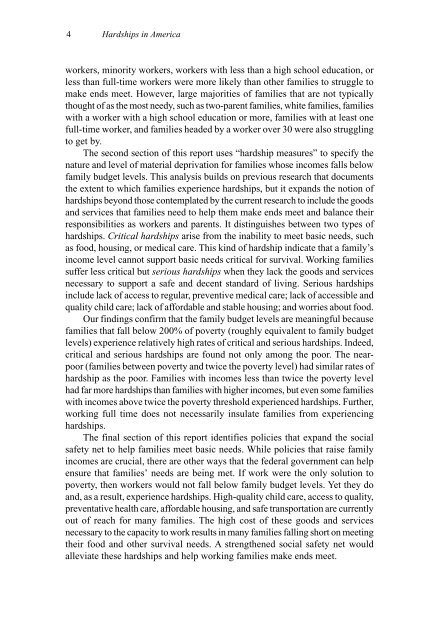Create successful ePaper yourself
Turn your PDF publications into a flip-book with our unique Google optimized e-Paper software.
4 Hardships in America<br />
workers, minority workers, workers with less than a high school education, or<br />
less than full-time workers were more likely than other families to struggle to<br />
make ends meet. However, large majorities of families that are not typically<br />
thought of <strong>as</strong> the most needy, such <strong>as</strong> two-parent families, white families, families<br />
with a worker with a high school education or more, families with at le<strong>as</strong>t one<br />
full-time worker, and families headed by a worker over 30 were also struggling<br />
to get by.<br />
The second section of this report uses “hardship me<strong>as</strong>ures” to specify the<br />
nature and level of material deprivation for families whose incomes falls below<br />
family budget levels. This analysis builds on previous research that documents<br />
the extent to which families experience hardships, but it expands the notion of<br />
hardships beyond those contemplated by the current research to include the goods<br />
and services that families need to help them make ends meet and balance their<br />
responsibilities <strong>as</strong> workers and parents. It distinguishes between two types of<br />
hardships. Critical hardships arise from the inability to meet b<strong>as</strong>ic needs, such<br />
<strong>as</strong> food, housing, or medical care. This kind of hardship indicate that a family’s<br />
income level cannot support b<strong>as</strong>ic needs critical for survival. Working families<br />
suffer less critical but serious hardships when they lack the goods and services<br />
necessary to support a safe and decent standard of living. Serious hardships<br />
include lack of access to regular, preventive medical care; lack of accessible and<br />
quality child care; lack of affordable and stable housing; and worries about food.<br />
Our findings confirm that the family budget levels are meaningful because<br />
families that fall below 200% of poverty (roughly equivalent to family budget<br />
levels) experience relatively high rates of critical and serious hardships. Indeed,<br />
critical and serious hardships are found not only among the poor. The nearpoor<br />
(families between poverty and twice the poverty level) had similar rates of<br />
hardship <strong>as</strong> the poor. Families with incomes less than twice the poverty level<br />
had far more hardships than families with higher incomes, but even some families<br />
with incomes above twice the poverty threshold experienced hardships. Further,<br />
working full time does not necessarily insulate families from experiencing<br />
hardships.<br />
The final section of this report identifies policies that expand the social<br />
safety net to help families meet b<strong>as</strong>ic needs. While policies that raise family<br />
incomes are crucial, there are other ways that the federal government can help<br />
ensure that families’ needs are being met. If work were the only solution to<br />
poverty, then workers would not fall below family budget levels. Yet they do<br />
and, <strong>as</strong> a result, experience hardships. High-quality child care, access to quality,<br />
preventative health care, affordable housing, and safe transportation are currently<br />
out of reach for many families. The high cost of these goods and services<br />
necessary to the capacity to work results in many families falling short on meeting<br />
their food and other survival needs. A strengthened social safety net would<br />
alleviate these hardships and help working families make ends meet.



